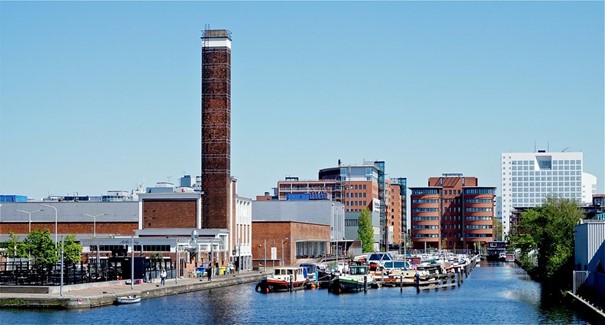Energy harbor in the Binckhorst
Watersport Association (WSV) "de Vlietstreek" has been located in the Binkhorst for many years. With about 105 berths, it is a sizeable modern harbor in this development area. The harbor is equipped with modern jetties...
Centre of Expertise Mission Zero

Watersport Association (WSV) "de Vlietstreek" has been located in the Binkhorst for many years. With about 105 berths, it is a sizeable modern harbor in this development area. The harbor is equipped with modern jetties offering power facilities for the vessels. There is also a canteen and workshop for members. The latter two need to be replaced, which raises the matter of sustainability. The harbor has a mix of users with recreational boats for overnight stays and sloops and punts for day recreation. The recreational boats are usually in the harbor year-round, while the sloops and punts go into storage during the winter. There are some berths that have electric propulsion, but most vessels are propelled by internal combustion engines. The recreational vessels usually also have power consumption while in the harbor. However, WSV “de Vlietstreek” has stated in its regulations that shore power (a connection to the power supply on the dock) may only be used when someone from the crew is present. Because of these regulations, most of the recreational boats in this harbor have solar panels for their own use. This makes most of the vessels self-sufficient, but adjustments will need to be made in order to deliver energy back to the grid. Many members are working on sustainable development at the hobby level, but it is also a focus at the national level. A housing committee is now working on a future vision of the possibilities offered by the harbor, and the DC-Lab of the Haagse Hogeschool is collaborating on the research and realization of this future vision.
Project Goal
With more than 50 panels and 200 batteries, there is a small power plant in the harbor. These run in sets autonomously without connection to the jetty grid. Solar panels and a dynamo on the main engine feed the on-board batteries.
To be able to deliver back to the grid, adjustments are needed for each ship. The aim is to open up mobile renewable generation and storage from ships to the grid and add to the total number of renewable generators available to society. Part of the goal is also to possibly set up and power a local grid at locations without a grid structure. First, there must be a shore power connection. Furthermore, a system must be developed which, via the relationship between battery voltage and state of charge, links the inverter and enables recharging.
So far, there is no device or technology on the market that makes this link. So it needs to be developed, and that is what the DC Lab of The Hague University of Applied Sciences is working on. In this collaboration, the goal is to solve this problem and to make this technique widely available.
Two groups are each working on their own assignment. One group has to develop the connection, "the device ", to connect the ship's energy installation to shore power and
the other group is investigating the possibilities of turning the port into a smart grid. With a survey, students surveyed the members about the different installations and capabilities in order to establish the set of requirements and desires for designing the solution in a paper and working prototypes.
Final product/intended results
With the possibility of supplying back from member vessels, WSV “de Vlietstreek” has the opportunity to take big steps in sustainability and possibly become energy neutral or even supply more back itself. Towards the future, the increase in electric boating is also a challenge. With the current infrastructure and capacity it will not be possible to charge many ships at the same time. If independent power can be supplied then this does become possible. Research still needs to be done on this to work towards a future-proof marina. Thus, the energy delivered back can be used at the businesses and homes located around the marina. The intended results are spread over the quarters of 2022.
Q1
Research capacity and gauge existing systems through a survey and establish preconditions
Q2
Research feed-in techniques and put together the test installation
Q3
Design systems and components and test the mockup in the lab
Q4
Test and realize a prototype in a working installation, and modify 20 installations on ships
Project leader
Nico Persoon
Researchers involved
Diëgo Zuidervliet
Start and end date of project
1st quarter 2022 to 4th quarter 2022
Courses and/or minors involved
Two project groups of 4 Electrical Engineering students were recruited and started the project around Feb. 2.
Funding
Subsidy scheme energy from the neighborhood challenge The Hague 2021
Partners
- The Hague University DC Lab
- Practorate Energy Transition
- WSV de Vlietstreek
- Roc Mondriaan
- Municipality of The Hague
- DC Opportunities
- Dynniq